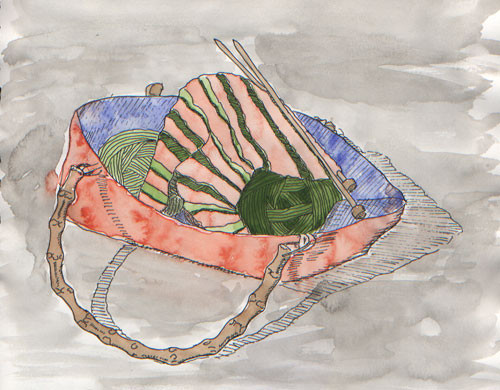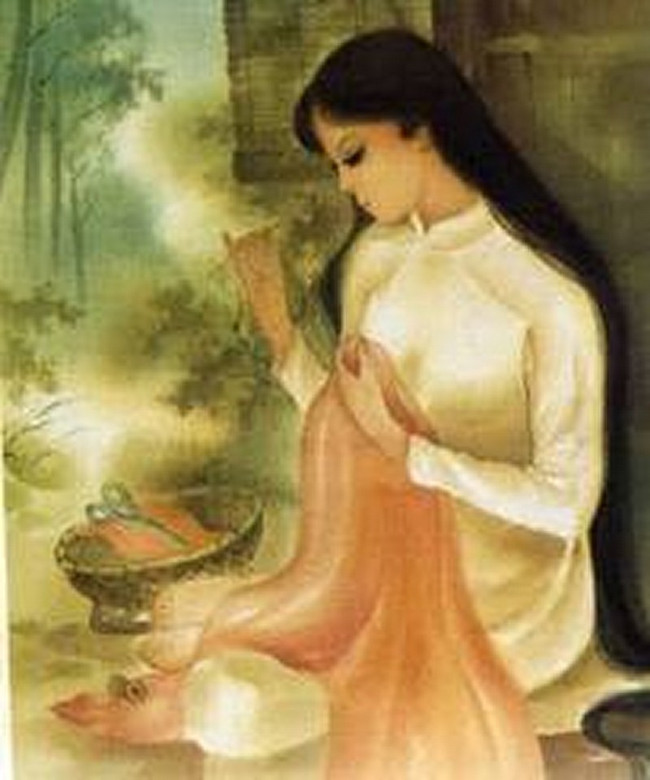The “Nang Ban Cold” is a term that has a fairy tale-like quality in Vietnamese folklore, referring to the last cold snap of winter that occurs in the third lunar month in Northern Vietnam, or generally, a late cold spell.
There is a proverb that says: “January is cold and icy, February is cold and wet, March is the cold of Nang Ban.” January and February are clearly remnants of the old year’s winter… Trees begin to bud, flowers are just starting to bloom, and the sun will surely cause them to wither. However, why is it still cold in March?
What is the “Nang Ban Cold,” and why is the cold in March called “Nang Ban”? According to popular terminology, “Nang Ban Cold” refers to the last cold spell of winter that occurs in the third lunar month in Northern Vietnam. After several warm days, even hot days reaching 32-33 degrees Celsius, people can’t help but shiver as the “Nang Ban Cold” sweeps back in.
Nang Ban is a gentle, virtuous girl who is very hardworking and dedicated. She treats everyone with great care and devotion.
This nature does not allow her to do anything carelessly. From washing chopsticks and bowls to sweeping the yard and house, everything must be as clean as a whistle. Items must be arranged neatly and orderly. Meals must be delicious and sticky. In farming, from plowing to weeding, watering, and fertilizing… everything must be meticulous and careful. When it comes time to plant seedlings, she is even more painstaking: hundreds of thousands of clumps must be in perfect rows and identical.
Her work in spinning silk, weaving threads, and sewing is even more intricate and skillful. Each thread is meticulously crafted. Not a single stitch is left out, and no mistake can be seen. The decorative patterns and designs seem to have the touch of a divine hand: both soft and graceful yet shiny and refined…
In the whole world, perhaps no one can do what she does. People, whether a lot or a little, often find themselves in a hurry, anxious. Especially when work has to be prolonged and becomes monotonous, haste and anxiety are even more likely to occur. But for her, patience and perseverance have become her nature, and passion has turned into obsession, from the beginning to the very end…
When she reached marriageable age, she also became a daughter-in-law like everyone else, but her nature remained unchanged, not a bit altered. No one ever criticized her, even with half a word. And if her carefulness made her work slow, that was merely an observation from those around her, who did not truly understand her. When she heard such remarks, she never defended herself, but she never changed her way of working either.

Seeing her husband lacking warm clothes, she immediately started knitting a warm, beautiful sweater for him.
She married at the beginning of winter, right after the harvest was completed. Seeing her husband lacking warm clothes, she immediately began spinning silk to prepare to knit a truly warm and beautiful sweater for him.
Her silk and wool threads were both even and incredibly smooth. Then she searched for various tree barks, mixed and dyed them into different colors. Next, she sat down to design the sweater and its decorative patterns. After much flipping and turning, only when she was most satisfied did she start knitting.
Oh! Her stitches were so smooth and graceful! It was as if there were magical powers at work, not just the hands of a human. She poured all her heart into the work, and each stitch seemed to carry a song rising from her heart.
Time slipped away gently and quietly. But for her, time seemed to never exist; day and night passed by like shadows… January and December came and went without her noticing. For her, work was always like it had just begun, always fresh and full of enthusiasm. Yet three months had passed…
Nang Ban knits a sweater for her husband
It took three months just to knit the sleeves.
Indeed, it was true! But for her, that did not matter at all. For her, only the work and the perfect completion of the work were truly important! Therefore, right after finishing the sleeves, she continued to knit the body of the sweater. And so, day by day, she was seen engrossed in knitting.
She knitted as if she had never done anything so significant before. She knitted as if the world was created just for her to knit! Therefore, regardless of January and February coming and going, regardless of the cold rain and biting winds, she remained diligent, wholeheartedly focused on her work. And finally, the inevitable happened: at the beginning of March, she had finished knitting the entire warm sweater for her husband!
Oh, the sweater! The most exemplary product in the world! Nowhere and at no time could anyone else create such a product. Her joy was indescribable. Her soul felt as if it was soaring up to the clouds, sharing joy with everyone. But alas! Just then, the weather turned sunny, and the cold was gone!
Nang Ban was very sad! It felt as if the sky had suddenly collapsed! Because how much thought and effort she had put in! And how many feelings and dreams she had poured into every stitch!
She loved and cherished her husband deeply. For several months, he had silently waited. Yet, even a small joy, a little happiness could not be returned! Oh! O heavens and earth, is there anyone who understands the heart of Nang Ban?
And so, instead of joy, she sat with her face in her hands, crying. The cries were full of sorrow and despair…
Ruling over the heavenly realm, for many ages, is the Jade Emperor, the great wise ruler, who often has to take care of many significant matters, but he never forgets the pleas of the smallest and most unfortunate beings.
He was sitting when he suddenly heard the sound of Nang Ban’s crying echoing. Her cries were so poignant and sorrowful that they stirred his compassion, and immediately he summoned the two deities, Nam Tao and Bac Dau. He instructed them to investigate the situation thoroughly, and after understanding, he sat in deep thought for a long time before declaring:
– I know that in the mortal realm, many people live in hardship and endure much injustice, especially women. They toil day and night to provide for themselves and fulfill many duties to society and their families. Nang Ban is indeed the most exemplary woman of love, generosity, diligence, and patience, deserving of reward.

Nang Ban knitting a sweater for her husband.
Now I decree that every year, at the beginning of the third lunar month, the cold will last a few more days. So that women with altruistic hearts like Nang Ban, if they take longer to knit a sweater for their husbands, will also be satisfied. Because after knitting a sweater, it must always be tried on. But you two remember, the cold should only be mild and brief.
Upon hearing this, the two deities, Nam Tao and Bac Dau, stood silent for a long time, hesitant, but then boldly reported:
– Your Majesty, if you decree this, it may not be fair. Should a few people’s needs cause everyone to endure more cold? It would be difficult to manage.
The Jade Emperor waved for them to sit down and calmly said:
– I know. I know… But I have also considered it carefully. Kindness and perseverance should always be encouraged. An exemplary person will serve as a model for everyone. Surely you both remember that you have reported to me about the many careless, deceitful, and even vile acts that people have committed? I have decided this to remind them that whatever they do, they must be persistent and thorough, and cannot be careless. Carelessness in work will gradually lead to carelessness in treatment, and ultimately to ruthless behavior towards one another, without any thought… I have made this decision to remind them constantly.
Upon hearing this, the two deities, Nam Tao and Bac Dau, found it reasonable. They quickly stood up and bowed to thank the Jade Emperor. From then on, they frequently urged the weather and cold deities to fulfill their duties each year. However, there were times when the cold was a bit excessive. This was because these deities, after all, sometimes still slacked off in their work…
Thus, it became a custom that every year around March, although the cold season had passed and the hot season had arrived, there would sometimes be unexpected cold for a few days, which people called the “Nang Ban Cold.”
The proverb states: “January is cold and icy, February is cold and wet, March is the cold of Nang Ban” for this reason.
Every year, whenever the March cold arrives, it brings along various other weather phenomena such as whirlwinds and hail. Therefore, you should be cautious and take care of your health.
Scientific Explanation for the Nang Ban Cold Phenomenon
The Nang Ban Cold usually occurs from late March to early May in the Gregorian calendar. This is essentially a late cold snap caused by cold air from the North sweeping in at the end of March and even in April, when the weather has warmed up considerably.
Based on cloud charts from monitoring stations and measurement tools, it can be observed that during this time, cold air is still active, and there are still cold spells causing chilly weather.
The typical weather pattern associated with the “cold of the Bân” often includes light rain and drizzle due to the late-season cold air mass not only moving from the North to the South but also slightly shifting eastward through the Gulf of Tonkin, bringing moisture from the sea.
During this period, temperatures can drop by 5 to 8 degrees Celsius, causing the average temperature to fall below 20 degrees Celsius. Additionally, some areas may experience heavy rain and thunderstorms, which can bring whirlwinds, hail, and strong gusts of wind.
In reality, the “cold of the Bân” is not a severe cold spell like many others experienced during winter. However, due to the general warming of the region compared to December, people often feel much colder as a result.
Due to climate change in Vietnam specifically, and globally in general, the “cold of the Bân” does not occur every year, although some years may see several occurrences, each lasting a few days.
According to statistics from the National Center for Hydro-Meteorological Forecasting, the frequency of cold spells during this time is only about 30%. This means that, on average, there are about three occurrences of the “cold of the Bân” every ten years.
Factors such as global warming, prolonged strong El Niño events, and urbanization effects are some of the reasons cited to explain this change.
In Vietnam, the “cold of the Bân” has a certain impact on agricultural production because the timing of its occurrence coincides with the period when crops, especially rice, are in the flowering stage. The low temperatures can affect the normal development of rice plants, impacting rice yields.
Moreover, sudden cold spells can affect the health of the elderly and young children, as their bodies may not be able to adapt quickly. Therefore, there is a saying in folk culture: “In March’s cold, the old lady dies of frost.”





















































